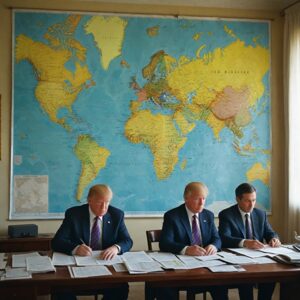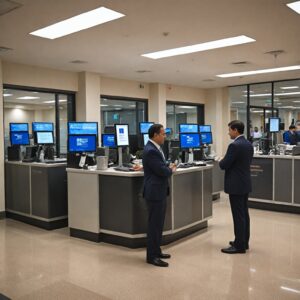Summary
The article provides a comprehensive analysis of the U.S. economy under the administrations of Joe Biden and his predecessor, Donald Trump. It evaluates their respective economic policies, key legislative actions, and the impact of external factors on the economy. Biden’s administration, often referred to as ‘Bidenomics,’ demonstrated significant growth in the GDP, wages, employment, and household net worth in its first year. However, the rise in inflation has been a persistent issue, leading to dissatisfaction among consumers. On the other hand, Trump’s administration is credited for significant deregulatory actions which reportedly saved American businesses and consumers billions of dollars.
A comparison of the economy under both presidencies reveals divergent economic indicators, with Biden experiencing historically robust GDP growth and Trump witnessing a rise in the debt-to-GDP ratio. However, both administrations faced common issues such as high inflation and concerns related to public finances. The impacts of legislative actions under both administrations on the economy are also evaluated, with Biden’s Infrastructure Investment and Jobs Act and Trump’s deregulatory measures being key highlights.
The influence of external factors such as the COVID-19 pandemic and geopolitical events like Russia’s invasion of Ukraine on the economy during both presidencies is also explored. Public perception and media influence on the economy are discussed, with polls indicating a more favorable view of the economy under Trump. Finally, the article explores the economic challenges faced by both administrations and provides concluding remarks on the potential long-term implications of their policies on the U.S. economy.
Background
The Biden administration inherited an economy that demonstrated significant strength and has made historic investments to bolster this trend . These investments include the Infrastructure Investment and Jobs Act (IIJA), the CHIPS and Science Act, and the Inflation Reduction Act. These legislative actions have spurred record levels of public and private infrastructure investment across the country and are expected to enhance productivity growth over the long term .
In 2021, Biden signed two additional major pieces of longer-term economic legislation aimed at boosting semiconductor investments and public basic research, while also expanding green energy and health insurance subsidies . The Biden administration saw strong growth in real GDP, wages, employment, stock market returns, and household net worth in its first year, although inflation also increased as the economy recovered from the pandemic-induced recession of 2020 .
One key feature of the Biden economy, colloquially known as ‘Bidenomics’, has been efforts to address the COVID-19 pandemic, including relief measures, vaccination drives, and investment in infrastructure. The approach also includes measures to strengthen the social safety net, funded by tax increases on higher-income individuals and corporations . However, consumer sentiment regarding the economy has shown dissatisfaction, primarily due to inflation .
The Biden administration’s economic policy has been marked by significant legislation, including the American Rescue Plan Act, which provided $350 billion to help states, localities, tribal governments, and territories mitigate the financial impacts of the pandemic . This legislation has transformed the economic landscape, with over 8 million Americans who were jobless in March 2021 returning to work .
Criticism towards Biden’s economy exists. Polls have indicated a broad public discontent with the Biden economy, with a March 2024 CBS News poll finding that 65% of Americans viewed the economy under Biden’s predecessor, Donald Trump, as good, whereas only 38% expressed a similar positive opinion of the economy under Biden .
In terms of regulatory changes, the Trump administration has made significant regulatory and deregulatory changes across key policy areas such as environmental, health, labor, and more . One of the key pieces of legislation criticized by Trump was the CHIPS Act, which was aimed at reducing the United States’ reliance on Asia for semiconductors .
Inflation has been a persistent challenge for the Biden administration, with a rapid run-up in prices post-pandemic leading to the highest inflation in more than 40 years . This has led to higher costs for everyday items and has impacted Americans’ views of the economy, with voters consistently citing inflation as their top economic concern .
Comparative Analysis of Economic Performance
The performance of the U.S. economy is a crucial subject matter in the political discourse, largely influencing voters’ preferences. Therefore, it is important to analyze the comparative economic performance under the presidencies of Donald Trump and Joe Biden.
Inflation and Public Finances
Inflation and public finances have remained significant concerns under both administrations. During Trump’s tenure, the government debt-to-GDP ratio increased from 105 percent at the end of 2016 to 126 percent at the end of 2020.
Economic Growth
Under the Trump administration, the average annual GDP growth during the pre-Covid period (2017-2019) was 2.6 percent. Despite the increase in labor supply and business investment, gross domestic product would only be 0.7% higher on average each year during the 2018–2027 period relative to the CBO baseline forecast, a relatively minor economic impact. In contrast, during the Biden administration, the real GDP rose significantly by 12.6 percent, an expansion that was described as historically robust. The US’s GDP growth under Biden’s administration exceeded that of other G7 countries in 2023 and is expected to maintain this trend in 2024.
Unemployment
Unemployment is a key indicator of the economy’s health. Despite the Covid pandemic and high inflation, the labor market under Biden’s administration remained strong with more than 15 million jobs created. The unemployment rate reached its lowest in more than five decades at 4.1 percent. While Trump saw the jobless rate decrease to its lowest since the Nixon administration during his first term, this changed with the sudden loss of over 20 million jobs due to the pandemic.
Debt
The growth of public debt varied under the two administrations. Under Trump, the public debt increased by $5.9 trillion during the first three years and five months, and $7.2 trillion over his full term. On the other hand, public debt grew by $6.0 trillion during Biden’s first three years and five months in office. However, the debt as a share of GDP grew by 23 percentage points under Trump but remained relatively flat under Biden.
Impact of Key Legislative Actions on Economy
Presidential administrations and Congress have a significant influence on the economy, in part through the setting of fiscal policies. For example, under Presidents Trump and Biden, policies and legislation passed have set the national debt on a trajectory to reach a record share of the economy.
Biden Administration
The Infrastructure Investment and Jobs Act, signed into law in November 2021, provided an additional $550 billion in investment to repair infrastructure and expand passenger rail and broadband. The Congressional Budget Office (CBO) estimated the deficit impact of this act at $250 billion.
The American Rescue Plan Act provided financial support to states, localities, tribal governments, and territories to offset the economic impacts of the COVID-19 pandemic. It also offered tax relief to Americans who lost their jobs during the pandemic by waiving federal income taxes on the first $10,200 of unemployment benefits received in 2020.
Bidenomics, which includes these measures, has been credited with triaging challenges such as congestion at U.S. ports and putting downward pressure on prices to help consumers. Unemployment rates, a lagging economic indicator, are influenced by such economic policies.
Trump Administration
The Trump administration is noted for its deregulatory actions, which are estimated to have saved American consumers and businesses over $220 billion per year. Sixteen pieces of deregulatory legislation signed under this administration resulted in an expected $40 billion increase in annual real incomes.
However, some actions by the Trump administration were criticized for potentially undermining the independence of legal professionals and regulatory agencies. For example, President Trump’s executive order requiring independent regulatory agencies to submit their major regulations to the White House Office of Management and Budget (OMB) for review was opposed by Congressman Cohen and others who viewed it as an assault on the rule of law.
Both administrations have made key legislative actions that significantly influenced the U.S. economy, illustrating the impact presidents can have on GDP.
Influence of External Factors on Economy Under Both Presidencies
The role of a president in shaping a nation’s economy is significant, as evidenced by the impact of presidential fiscal policy decisions on the GDP. The economy often plays a pivotal role in elections, and candidate’s views on economic issues can greatly influence voter opinion. For instance, the handling of economic issues was a deciding factor in voter choice between Presidents Donald Trump and Joe Biden.
Trump’s Presidency
During President Trump’s tenure, the economy was significantly impacted by various external factors, including the COVID-19 pandemic and trade policies. In his first term, public opinion was largely dominated by health care concerns, particularly after the outbreak of COVID-19. However, Trump’s economic response to the pandemic, including generous monetary policy and economic stimulus through the Coronavirus Aid, Relief, and Economic Security (CARES) Act, was perceived positively.
One of the defining policies of Trump’s presidency was his approach to trade. Believing that ‘tariffs are about making America rich again,’ Trump transformed trade policy into a significant economic tool. Starting in April 2018, tariffs were imposed on approximately $380 billion worth of imported goods, the bulk of which were from China. Despite criticism, the thrust toward deregulation and the expectation of tax cuts led to a rise in business confidence, investment, and real GDP.
Biden’s Presidency
The early months of President Biden’s tenure have seen the economy influenced by ongoing pandemic effects, as well as issues such as inflation and the invasion of Ukraine. A significant issue for Biden has been the economic impact of the COVID-19 pandemic, which has influenced spending, revenue collections, and the size of Treasury’s cash balances and other financial assets. The federal government has continued to use fiscal stimulus to support the economy during this period, but this has contributed to high inflation, currently a significant public concern.
Moreover, Russia’s invasion of Ukraine in February 2022 has further shaped economic issues under Biden’s presidency.
Public Perception and Media Influence
The public’s perception of a politician is often measured through net favourability, which gauges the share of the public who have a “very favourable” or “somewhat favourable” opinion of a politician, deducting those who have a “somewhat unfavourable” or “very unfavourable” view. In the 2024 presidential contest, this perception played a crucial role, as did voters’ outlook on key economic metrics such as gross domestic product (GDP), inflation, unemployment, and public finances.
There appeared to be a broad discontent among the public with the economy under the Biden administration, even though consumers continued to spend and change jobs as though they had a positive perception of the economy. In fact, polls such as the March 2024 CBS News poll indicated that while 65% of Americans viewed the economy under Biden’s predecessor, Donald Trump, as good, only 38% held a similar positive opinion about the economy under Biden.
The media’s influence on public perception of the economy is not to be overlooked. Despite a strong economy, many voters, influenced by media narratives, felt the pinch of rising grocery prices and demanded change. This discrepancy between the actual state of the economy and the public’s perception of it suggests a disconnect fuelled largely by media narratives.
Trump’s victory over Vice President Kamala Harris in the election indicates a significant voter discontent about the state of the economy that had been building up since inflation surged under President Joe Biden following the COVID-19 pandemic.
Economic Challenges and Uncertainties Under Both Administrations
During Trump’s administration, the U.S. economy faced a host of significant challenges. These included a notable increase in national debt, disruptions caused by trade wars, and an unprecedented economic collapse brought about by pandemic shutdowns. Amid these trials, questions arose concerning how Trump would deal with the situation of public finance in the U.S. and how his administration would react if the economy were to sputter, with GDP growth dropping below 1.5 percent.
President Biden’s administration, while managing to create more job opportunities, appeared to be moving towards a situation where the door to economic prosperity was slowly closing. This impression was backed by data on full-time employment, which had shown a steady rise during the Trump era but remained stable during the subsequent year. The economy proved to be a significant issue among voters in swing states, as evidenced by a February Morning Consult/Bloomberg survey.
Biden’s economic agenda has been credited with providing working families with some degree of respite. The administration was noted for its ability to deal with challenges, such as congestion at U.S. ports, promptly.
However, as Biden prepares for his reelection bid, his campaign will have to grapple with an economy in a much more precarious state than it was when he assumed office. High inflation, deteriorating household finances, and signs of weakness in the job market are among the key issues that his campaign will have to address.
Concluding Remarks
Under the Obama administration, significant strides were made towards ending the war in Iraq and reducing troop presence in Afghanistan. However, it has been observed that the Trump administration may have influenced the economic momentum initiated by the Biden administration. Despite these developments, the US economy showed signs of prosperity, with the highest real GDP growth among the G7 countries in 2023.
The success of the CHIPS program, a critical part of the economic plan, has been lauded as one of the significant achievements of the period. This, in tandem with the proposed changes to the USMCA agreement, was predicted to boost the US real GDP by 0.35% and total employment by 0.12%.
One significant factor impacting the economy has been the reduction in immigration during the Trump administration. Immigrants have been observed to start companies at twice the rate of Native Americans, and half of the companies in the Fortune 500 were initiated by immigrants or their children. This dynamic could have potential long-term implications for the U.S economy, particularly regarding productivity and innovation.
In light of these considerations, it becomes apparent that while the U.S economy has demonstrated significant growth and stability under different administrations, certain policies and decisions may have a lasting impact on its future trajectory. The data collected from the 2017-2019 Trump economy and the 2021-2023 Biden economy will be integral in shaping this understanding.
























